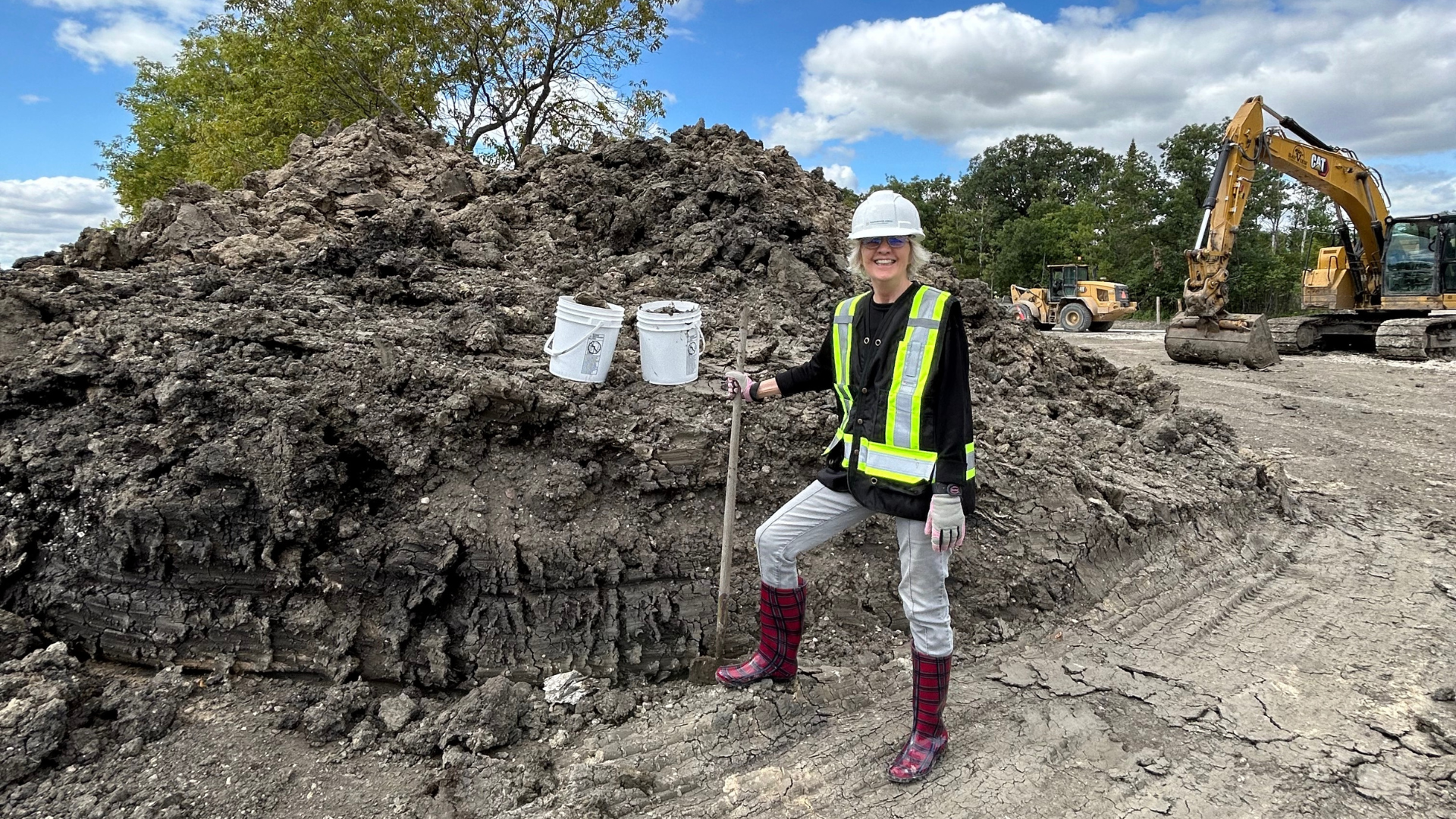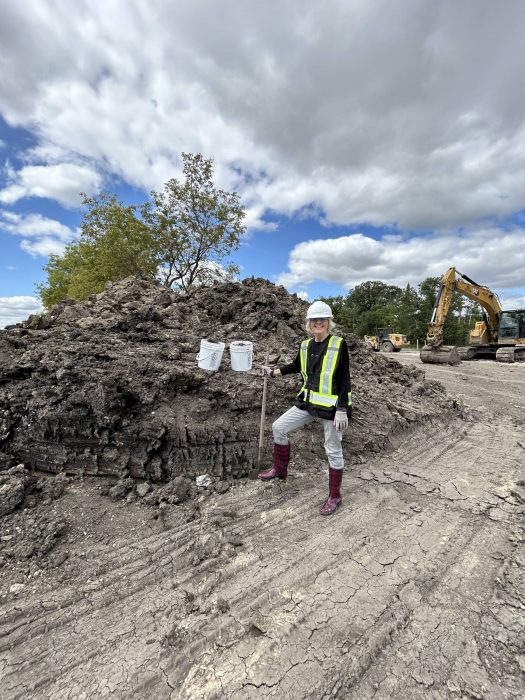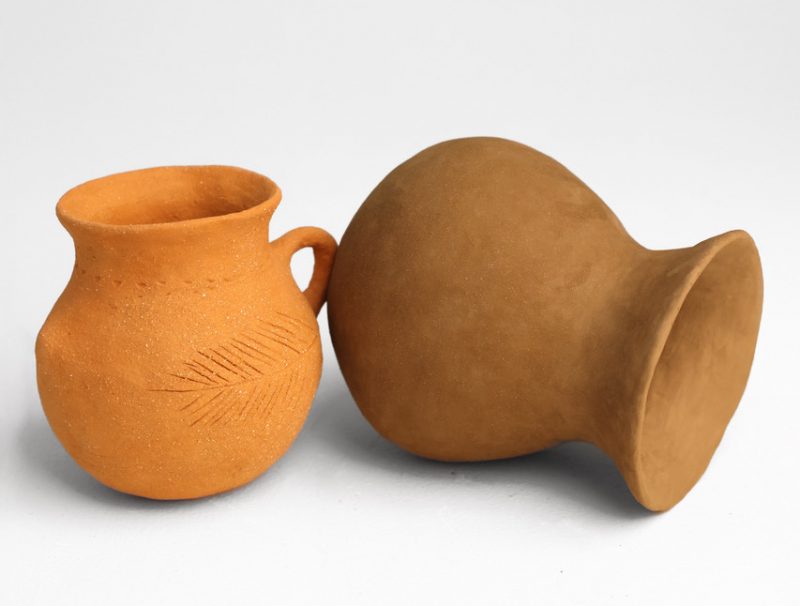
Professor Grace Nickel onsite at the Southwood Circle construction site harvesting local clay, 2024
Unearthing Sustainability: Local Clay Project in School of Art’s Low-Fire Ceramics Class
October’s Sustainability Month at the University of Manitoba brought new light to the impactful and innovative Local Clay project led by School of Art Professor Grace Nickel and her students in the Low-Fire Ceramics class. This hands-on project exemplified sustainable practices in fine arts by utilizing local resources, reducing environmental impacts, and fostering collaboration within the community.
Going Beyond Traditional Sources: Sustainable Clay
For this project, Nickel and her students avoided commercial mining and the use of factory-produced clays, opting instead for clay sourced from the nearby Southwood Circle construction site. This local earthenware came with several environmental benefits. By tapping into resources already on hand, the project sidestepped the environmental impact of long-distance transportation, keeping the carbon footprint low while significantly reducing costs. This red earthenware clay was naturally suited for low-temperature firing, making it a perfect match for the Low-Fire Ceramics class while conserving energy.
Energy-Efficient Firing Techniques
The project’s commitment to sustainability went further through once-firing, a technique that avoided the typical two-step firing process, resulting in even less energy usage. Each step was thoughtfully designed to reduce environmental impact, from the selection of materials to the final firing process, demonstrating that local and accessible resources could meet students’ artistic needs while supporting broader sustainability goals.

Professor Grace Nickel onsite at the Southwood Circle construction site harvesting local clay in August 2024 for her Fall semester Low-Fire Ceramics course.
A Malleable and Collaborative Process
The clay itself was noted for its remarkable plasticity and malleability—qualities that made it an ideal material for student projects. Through collaboration with Southwood Circle construction, Nickel was granted access to abundant, high-quality clay, underscoring the potential for community partnerships in sustainable art practices. She documented the full journey from sourcing to firing, illustrating the process and challenges of working with local clay as students transformed it into unique pieces that reflected both their artistry and a commitment to sustainability.
Honoring Process and Place
As the Local Clay project evolved, students in the Low-Fire Ceramics class learned not only the techniques of working with natural materials but also the responsibilities that came with them. Their work became a testament to what was possible when art met environmental awareness, positioning the Local Clay project as a powerful example of sustainable practice within the art community at UM.
Student reflections capture the essence of this journey
Wendy Peck shared, “When you use clay gathered and processed where you are working, you connect with your location in a magical, tactile way. In addition to the assigned projects, I am creating a mug with the U of M clay to forever mark the years I spent pursuing my dream. It doesn’t get more local than this.”
Anaies Mehrabian, another student, commented on the profound connection with nature that working with local clay fosters: “As a ceramic student, I am captivated by the profound connection between working with local clay and the essence of Mother Nature. Utilizing local clay has deepened my understanding, as I’ve engaged not only with the material itself but also with its creation process. The unpredictable nature of my pieces made with local clay empowers me to embrace the journey, allowing the clay to reveal its unique beauty and enhance my artistic vision in its own remarkable way.”

Work by MFA student Netsanet Shawl, created during the project, showcasing natural textures and colours unique to the local material.
MFA student Netsanet Shawl expressed, “Gathering and working with local clay has been incredibly inspiring. It has opened my eyes to the richness of our environment. It’s interesting to see how the colors and textures of the clay influence our creative processes. This project makes us appreciate the materials we often take for granted. The natural colors and textures of the clay give each piece a distinct character, reminding me of the connection between the Earth and the art.”
Noah Yaschyshyn described the process of transforming raw material into art: “We started with a bucket of material from the construction site on University Crescent. We broke it down, added water, wedged it, and made tests with the raw clay. It’s more intimate of a process than working with commercial clay; it made me think about my relationship to the material, where it came from, and why that’s important to me and my practice. I find ceramics to be community-oriented; we share the studio space, knowledge, ideas. We’re highly conscious of how our actions affect others, and that goes down to how they affect the environment as well. We’re working hard and thinking creatively and cooperatively. I think we’re setting a good example.”






